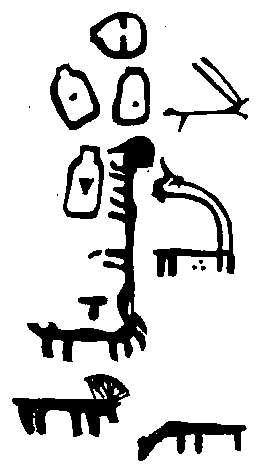|
Note: BC is used for Before Common Era, and
AD is used for Common Era.
 Strange
markings on a hillside curiously match the eloquent letters
on parchment. The graceful arch of vowels and consonants devised
in the 4th century CE are echoed in carvings showing
the sun, moon, and the exact locations of constellations from
the zodiac.
Strange
markings on a hillside curiously match the eloquent letters
on parchment. The graceful arch of vowels and consonants devised
in the 4th century CE are echoed in carvings showing
the sun, moon, and the exact locations of constellations from
the zodiac.
Our guide smiles,
and astonishingly covers 20,000 years of writing in a single
sentence, "From stone to paper, you can find the curve of our
people in a single path. Most people think the Armenian letters
began with Mashtots in 406 CE. But look here, and you will find
a divine inspiration 19,000 years before then."
Beginning from
astral symbols found on the Geghama Lehr (Mountain Range) between
Sevan and the Ararat Plain, including the signs of the Zodiac
and star positions at Karahundj and Metsamor; to Vishaps, obelisks
covered with cuneiform and pictograms, the Armenian language
has its roots. From the heart of Noah to the furthest stretches
of Mesopotamia, India and Europe, it spread to encompass most
of the Old World. The guide points to controversy and historical
fact, to scientific research and popular myth as he gathers
energy with his argument.
"The glories
of manuscript art have their ancestors, just as we do and if
you want to believe that the center of language and culture
came from this part of the world, then you canít also believe
the Armenianís were illiterate at the same time. There is a
source, and it came before the Mashtots Script."
|

